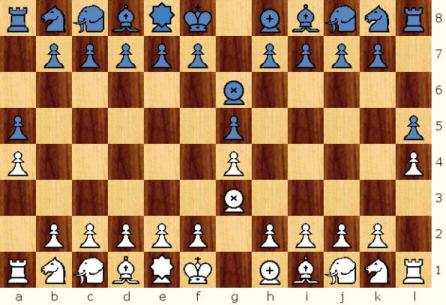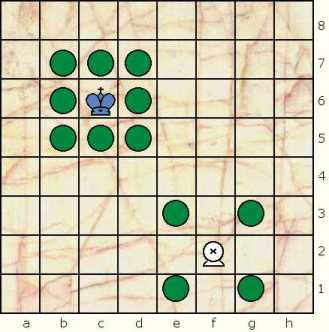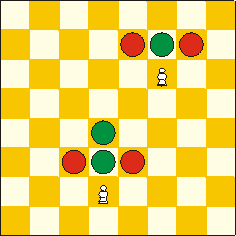Courier Chess Moderno
In this homemade composed Courier Chess Moderno set in addition to regular chess Kings, Rooks, Knights, Bishops and Pawns; I'm using a crown-less King to represent the Man, a crowned Bishop to represent a little Queen, a headless Rook to represent the Schleich or Jester, and Seirawan Elephants. The checkers men on the top picture are to be used for spare Queens in case they are needed for pawn promotions, a la Makruk (Thai Chess).
Why Courier Chess Moderno? We'll answer that question later below...
What is Courier Chess Moderno? Simply stated, as the name of the variant may suggest this is a "Modern" variant of the ancient game played in Germany in the Middle Ages Courier Chess.

Courrier Chess is best remembered by a 1508 Dutch painting by Lucas van Leyden: "The Chess Players".


At first Courier Chess (diagram above left) looks like a clumsy game played in a possibly not too easily available 12x8 board, and with very clumsy Shatranj Elephants. The need for the first four "forced" opening moves (diagram above right) demonstrates how clumsy the game probably was, and how from the begining there was a need to improve on the game to speed it up and to take away some of it's clumsiness. Even with the "forced" queen opening moves, the initial queens start off in opposite color squares, and can therefore not face eachother in battle; another improvable feature.
An additional flaw in the Courier setup, the Knight-Pawns (b & k files) are unprotected in the initial array.
H.G. Muller made a very interesting comment about Courier Chess:
Could it be that this game is on the direct line of the evolution from Shatranj to orthodox FIDE Chess?
It seems a nice 'missing link', with all Shatranj pieces still present, but introducing a modern piece in the form of the Couriers.
Especially if this game was popular it might have spread the fame of the modern Bishop, so that people that did not happen to have the clumsy 12x8 board around but just the old fashioned 8x8 might have decided on playing a more exciting game of 'mini-Courier' rather than that slow and boring Shatranj, throwing out the weakest pieces of Courier Chess: the Alfils and Wazir (Sleich).
I can even imagine that they sacrificed the weaker Ferz for the Commoner (Man), using the latter as Queen. After all, the Man was already standing next to the King (at the correct side!). This would have provided the first step of the evolution of the Queen to her modern form, adding orthogonal directions to her move repertoire. Replacing one piece by another in a popular game is quite a big step, since conservatism will bias people against the relatively unknown newcomer.
But if one shrinks a popular game to a smaller board out of necessity, a concious decision has to be made which piece to keep, and the pieces compete on an equal footing!
Even if Muller's "missing link" theory is not true, we can't argue that it actually makes a lot of sense. It also makes a nice little story about Courier Chess to go with van Leyden's 1508 painting.
I also want to add to Muller's theory that Courier Chess' initial forced 2-step pawn moves might have inspired the same move for all the pawns in Orthodox Chess.
If Courier Chess was indeed the "missing link" to our Orthodox Chess, then the rest of the story is already known...
Now, what if the 12x8 Courier Chess board and pieces were as readily avaible today as our 8x8 Orthodox Chess is now?
Would we still be playing Courier Chess in it's intact original form? I don't think so.
As it is, there have been numerous attempts to improve on the original game. To name a few: Courier-Spiel was also played in Germany in the 1800s and Modern Courier Chess was introduced by FIDE Master Paul V. Byway in the early 1990s. Other recent variations are Courier 'de la dama' and Furious Courier by Nuno Cruz. Eric Greenwood has 5 modified Courier setups and Charles Gilman has a variation called Courier de los Combinados.
Let's go back to the initial question: "Why Courier Chess Moderno?"
Courier Chess Moderno is my attempt to create a new Courier variant using some well known pawn move improvements (initial 2-step pawn move and "en passant") and some of the "Modern" principles, while still maintaining the flavour of Courier Chess. I would have loved to have called my variant Modern Courier Chess, but that name was already taken by FIDE Master Paul V. Byway. So I settled for Moderno (Modern in Spanish) after the original "Courier Chess" name.
In particular, the two "Modern" principles that I intended to use are my favourite Reverse Symmetry; and Symmetric Castling which comes hand in hand with Reverse Symmetry. Curiously, Symmetric Castling was already pioneered in the Courier-Spiel version played in Germany in the 1800s, so it's not such a big new improvement to the game.
But Reverse Symmetry is indeed new to the game, as I haven't seen it used in any of the Courier Chess variants.
I'm also changing (improving) the movement of one of the old Courier Chess' (and Shatranj) pieces, the Elephant.
Setup


Reverse Symmetry gives both players the same perspective of the board, of their own army as well as their opponent's army.
The Courier Chess Moderno opening setup is as follows:
White:
King f1; Queen (Ferz) g1; Rooks a1, l1; Knights b1, k1; Elephants c1, j1; Bishops (or Couriers) d1, i1; Man e1; Schleich (Wazir) h1; Pawns a2, b2, c2, d2, e2, f2, g2, h2, i2, j2, k2, l2.
Black:
King g8; Queen (Ferz) f8; Rooks a8, l8; Knights b8, k8; Elephants c8, j8; Bishops (or Couriers) d8, i8; Man h8; Schleich (Wazir) e8; Pawns a7, b7, c7, d7, e7, f7, g7, h7, i7, j7, k7, l7.
The Reverse Symmetry in Courier Chess Moderno allows the initial Queens to engage each other in battle, as they both now start on the same color (dark) squares; something that was imposible in the old Courier Chess game (since the little Queens are color-bound and they both started in opposite color squares).
Pieces
The king moves as in orthodox chess. The queen (Ferz) moves one square diagonally, just like in Courier Chess and Shatranj.
The man moves one square in any arbitrary direction, just like the king (above), but is non-royal (not hindered by check).
The rook and knight move as in orthodox chess.

The courier is called "bishop" in Courier Chess Moderno, and it moves as the orthodox chess bishop.
The schleich (Wazir) moves one square horizontally or vertically.
The pawn moves and takes like a pawn in orthodox chess (including the possibility to make a double step at its first movement and en passant capture). This is not such a novelty as it was also used in Courier-Spiel in the 1800s. The pawn promotion rule in Courier Chess Moderno is that a pawn promotes to a little queen (with the movement of the Queen in Courier Chess [1-step diagonally]) when arriving to the last rank, just like in Shatranj.

The new improved Courier Elephant (formerly called bishop in the original Courier Chess) is a novelty to Courier Chess Moderno. Instead of jumping two squares diagonally (like in Courier Chess and Shatranj), the Courier Chess Moderno's elephant moves like a Burmese Elephant, a Thai Bishop (Khon or Thon), or a Silver General (one step straight forward, or one step diagonally in any direction). See the elephants on j3 and e6 (represented by a black Silver General) below:
However, in addition to their regular Burmese movement, each of the Courier Chess Moderno's elephants do reserve the priviledge of a single Courier Chess Bishop or Shatranj Elephant (Alfil) 2-step diagonal leap for their first move, or a 2-step straight forward Dabbabah leap (similar to a 2-step Pawn move). So essentially, on their first move, elephants can play 1-step diagonally foward or straight forward; or they can leap [square being jumped can be vacant or occupied] 2-steps diagonally forward or straight forward. See the elephants on j8 and c1 (represented by a white Silver General) above. Once they have first moved (or leaped), elephants can only move like Burmese Elephants or Silver Generals (i.e. elephants on j3 & e6 above already leaped on their first move). The elephants can perform a capture with their initial leap.
With this major move improvement to the elephants in Courier Chess Moderno, not only can they now reach all 96 squares on the board, but enemy elephants can now engage each other in battle; while in Courier Chess (and Shatranj) the elephants (Bishop in the first game, or Alfil) kept their neutrality and could never meet each other in battle; plus additionally, each elephant could reach only 12 squares out of the 96 on the board.
The new Courier Chess Moderno's elephant moves give protection to the previously undefended b & k-pawns, and gives a very nice balance to the game as the pachiderms are now very useful short-range attacking pieces, that are similar in value to the long-range color-bound Bishops.
Bishops, Knights, Elephants and the Man can be exchanged between them and you can still have a very interesting playable game. The Rook continues to be the strongest piece; while the Schleich (Jester) is the weakest.
Rules
The goal of the game is to checkmate the opponent's King, or to exterminate the opponent's army and render his/her King "Bare".Rules for en passant, check, checkmate and Threefold Repetition Draw are like in Orthodox Chess.
The "Bare King" condition (also found in Shatranj) applies. It occurs when a player has taken his opponents last piece or pawn (i.e. only the opponent's King remains). This is a win for the first player unless the opponent's lonely King can then take the first player's last remaining piece or pawn on his next move (baring the first player's King as well, i.e. King vs King), which is then a draw.
Stalemate is a draw in Courrier Chess Moderno.
The 50-move draw rule is in effect, just like in Orthodox Chess.
Pawns promote to Courier queens upon reaching their last rank.
Castling is symmetric to both sides of the board, and the notation for castling is long (O-O-O) followed by the letter for the ending square of the King (i.e. O-O-Oc or O-O-Oj).
This table shows where the King and Rook end up and the notation for each type of castling.
| White castles a-side | c-castling | O-O-Oc | Kc1, Rd1 |
|---|---|---|---|
| White castles l-side | l-castling | O-O-Oj | Kj1, Ri1 |
| Black castles a-side | c-castling | O-O-Oc | Kc8, Rd8 |
| Black castles l-side | l-castling | O-O-Oj | Kj8, Ri8 |
Castling may only occur under the following conditions:
- Unmoved: The King and the castling Rook must not have moved before in the game, including a previous castling.
- Un-attacked: All of the squares between the king's initial and final squares (including the initial and final squares) must not be under attack by any opposing piece.
- Vacant: All the squares between the king's initial and final squares (including the final square), and all of the squares between the rook's initial and final squares (including the final square), must be vacant except for the king and castling rook.
- Castling cannot capture any pieces.
- The king and castling rook cannot "jump" over any pieces other than each other.
- A player may castle at most once in a game.
- If a player moves his king or both of his initial rooks without castling, he may not castle during the rest of the game.
- The king may not be in check before or after castling.
- The king cannot move through check.
Notes
Courier Chess Moderno is a great game to play OTB with a composed set (see pictures of a sample set at the top of this page) and with a Chess Clock. I recommend a minimum of 30 minutes per side on the clock for an interesting and enjoyable game. 15 minutes (or less ) per side might be only long enough to develop the pieces, and barely play into the middle game.
Game Courier Presets
Courier Chess Moderno presetCourier Chess Moderno preset #2 (with the Silver Generals shape instead of Elephants)
Courier Chess Moderno preset #3 (with the Galactic pieces)
Preset to the original ancient Courier Chess game
Game Courier Logs
Game Courier Logs for Games of Courier Chess ModernoGame Courier Logs for Games for the original ancient Courier Chess
To see actual games that have been played on-line, follow the link above.
Courier Chess Moderno (CCM) was created by Jose Manuel Carrillo-Muniz, from Puerto Rico in 2008.
Acknowledments
I want to thank my good friend Gary Gifford for the sugestion to add a 2-step straight forward leap to the Courier Chess Moderno elephant's opening repertoire. Originally the elephants could open with a Burmese Elephant move or a one-time 2-step diagonal leap, a la Shatranj Elephants or Alfils.Chess Variants by the Author:
- Modern Chess Complex
- Modern Random Chess (9x9)
- Contemporary Random Chess (8x8)
- Prime Ministers Chess (9x8)
- Pseudo-Modern Random Chess (9x9)
- Chess8400 (9x9)
- Prime Ministers Contemporary Random Chess (8x8)
- Prime Ministers Random Chess (9x8)
- Hia Chess (9x8)
- Modern Capablanca Random Chess (10x8)
- English Chess Complex
- Modern English Random Chess (10x10)
- International Contemporary Random Chess (10x10)
- International Fischer Random Chess (10x10)
- Courier Chess Complex
- Courier Chess Moderno (12x8)
- Mini Courier Chess Moderno (10x8)
- Silver Elephant Chess (10x8)
- Modern Ministers Courier Chess (11x8)
- Ajax Complex
- Ajax Chess (10x10)
- Ajax Orthodox Chess (8x8)
- Ajax Random Chess (8x8)
- Ajax Modern Random Chess (9x9)
- Ajax Ministers Chess (10x8)
- Ajax Falcon Chess (10x8)
- Ajax-Capablanca Chess (10x8)
- Korean Random Chess (9x10)
- Latrunculi XXI & Petteia XXI (10x8)
- Partnership Chaturanga (8x8)
Other Presets by the Author:
- Chaturanga - Davidson Variation
- Modern Chess Preset
- Fischer Random Chess Preset
- Makruk (Thai Chess) Preset
- Ajax Xiangqi (9x10) proposed by Charles Gilman
- Ajax Bigamous Chess (9x8) by Carlos Cetina
- Ajax Euchess (10x10) by Carlos Cetina
- Frolov Chess - Ajax Variation (9x9)
- Hiashatar (Mongolian Decimal Chess) (10x10)
- Milenium 3D Chess (8x8x3) by William L. D'Agostino
Other Pages by the Author:
- How to Generate Random Positions
- The Bishop Adjustment Rule
- The Modern Principles
- Reverse Symmetry
- The Prime Minister
- The Courier Elephant
- The 10x8 Variants
- Checkers Variants
 This 'user submitted' page is a collaboration between the posting user and the Chess Variant Pages. Registered contributors to the Chess Variant Pages have the ability to post their own works, subject to review and editing by the Chess Variant Pages Editorial Staff.
This 'user submitted' page is a collaboration between the posting user and the Chess Variant Pages. Registered contributors to the Chess Variant Pages have the ability to post their own works, subject to review and editing by the Chess Variant Pages Editorial Staff.
By Jose Carrillo.
Web page created: 2008-12-21. Web page last updated: 2008-12-27
